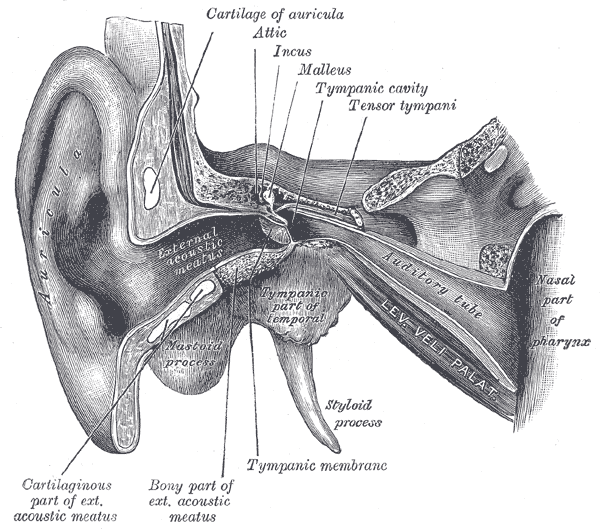Latin auris externa FMA 52781 | MeSH A09.246.272 TA A15.3.01.001 | |
 | ||
The outer ear is the external portion of the ear, which consists of the auricle (also pinna) and the ear canal. It gathers sound energy and focuses it on the eardrum (tympanic membrane).
Contents
Auricle
The visible part is called the auricle, also known as the pinna, especially in other animals. It is composed of a thin plate of yellow elastic cartilage, covered with integument, and connected to the surrounding parts by ligaments and muscles; and to the commencement of the ear canal by fibrous tissue. Many mammals can move the pinna (with the auriculares muscles) in order to focus their hearing in a certain direction in much the same way that they can turn their eyes. Most humans do not have this ability.
Ear canal
From the pinna the sound waves move into the ear canal (also known as the external acoustic meatus) a simple tube running through to the middle ear. This tube leads inward from the bottom of the auricula and conducts the vibrations to the tympanic cavity and amplifies frequencies in the range 3 kHz to 12 kHz.
Intrinsic muscles
The intrinsic muscles of the external ear are the:
Extrinsic muscles
The auricular muscles (or extrinsic muscles) are the three muscles surrounding the auricula or outer ear:
The superior muscles is the largest of the three, followed by the posterior and the anterior.
In some mammals these muscles can adjust the direction of the pinna. In humans these muscles possess very little action. The auricularis anterior draws the auricula forward and upward; the Auricularis superior slightly raises it; and the Auricularis posterior draws it backward.
Function
One consequence of the configuration of the outer ear is selectively to boost the sound pressure 30- to 100-fold for frequencies around 3 kHz. This amplification makes humans most sensitive to frequencies in this range — and also explains why they are particularly prone to acoustical injury and hearing loss near this frequency. Most human speech sounds are also distributed in the bandwidth around 3 kHz.
Clinical significance
Malformations of the external ear can be a consequence of hereditary disease, or exposure to environmental factors such as radiation, infection. Such defects include:
Surgery
Usually, malformations are treated with surgery, although artificial prostheses are also sometimes used.
If malformations are accompanied by hearing loss amenable to correction, then the early use of hearing aids may prevent complete hearing loss.
